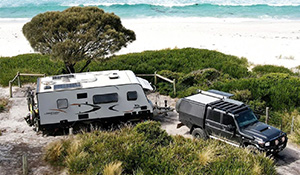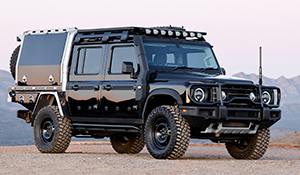Review – 2017 Toyota HiLux ExtraCab
THIS IS THE EIGHTH-GENERATION HILUX, released in late 2015 it is an improvement on the seventh-generation in pretty much every way from engine to body to suspension to efficiency. There’s now a huge range to choose from; 31 variants covering 2WD, 4WD, auto, manual, petrol, two diesels and body choices from single-cab to extra-cab to dual-cab, and a cab chassis too, available in three trim levels; Workmate, SR and SR5. Not every transmission is available with every engine or trim level, but even so there should be a HiLux for everyone. New to the HiLux range is Hi-Rider; a 4WD-specification version that is only 2WD, copying Ford’s move with the Ranger. But in keeping with the HiLux workaday ethos, there is no flashy top-end Wildtrak equivalent with special paint and luxury appointments. HiLuxes are built in Thailand, South Africa, Argentina, Malaysia, Pakistan and Venezuela. Vehicles for Australia come from Thailand, which accounts for around 70% of global production. The HiLux was extensively tested in Australia, clocking up some 650,000km and there was a further 400,000km of testing overseas. Max Gillard at the Toyota Technical Centre told us that “Australia bucks the trend for commonality of components across various markets, because Australian buyers have a different expectation and usage than some other markets. There are now two different HiLuxes; there’s one for Asia (mainly Thailand) where they use more sealed roads and need a softer suspension, and there’s another, tougher version developed for Australia and also sold in South Africa, Latin America, the Middle East and Russia.” Our test car is a manual 2.8L turbo-diesel extracab SR5, and it came with a factory towbar and Redarc electric brake controller. We had it for a week during which we did some offroading, towing, two six-hour country drives, some dirt road work and even used it on the school run.

What do we think of the looks?
The snub, overbite nose is not to everyone’s taste but the way of such things is that it will become familiar and more acceptable over time. Regardless of initial impressions, it gives the HiLux a distinctive and modern appearance, and it’s practical too with a good approach angle. Most utes look similar from the back and the HiLux is no exception but the rear light cluster is now more of a triangle, helping differentiate it from the previous model. The high-level brake-light position on the tailgate instead of up on the sportsbar is good as it’s not lost with a canopy or a load. The sportsbar is purely cosmetic and even has a sticker saying so. Once the sidesteps are thrown in the bin there’s very little left to break off or bend when you’re driving off-road.

What’s it like on the inside and how practical is it?
The HiLux may be a ute, but the interior isn’t completely spartan and it’s now comparable to any other Toyota. The designers put a lot of effort into making the HiLux more car-like, and it’s paid off… although Toyota car interiors are nowhere near the most stylish on the market.
There’s a dual glovebox, USB port and centre storage for a phone. There are drinks holders in each door, but unusually, just one in the centre. The climate control system is not split left and right. Dual-cab SR5s get a 220v socket, but not our extracab.
The steering wheel controls are simple and easy to use, and don’t get in the way when you’re twirling the wheel. The rest of the controls are nicely labelled, within reach and not hidden from view, important in a vehicle like the HiLux that may see many different drivers.
Our tester is an extra-cab, so it seats two in the front and two in the rear, just, with micro seats. There’s storage pockets on the back of the front seats, always handy for big maps (remember those?) and the like.
There are four doors – the rear two are backward-opening suicide doors which means the fronts must be opened before the rear can be opened. The rear windows angle open for a bit of ventilation.
Toyota supply decent rubber mats, but I’d like a bit more depth to them to catch mud and water. The rear seats are not actually completely cramped in the back for me and I’m just under 6ft, but it’s not as good as a dual-cab ute. I reckon extra-cabs are best used for storing extra kit, and you can fit a fair bit back there. The seat bases lift to reveal a bit more storage too.
The extra-cab tub length is 1805mm, and for comparison, the tub length of the dual-cab is 1569mm (+19mm over 7th gen). Make your own tradeoff, but I’d suggest off-road tourers should choose the extra or dual-cab over the single so you have a bit of cabin space for gear you don’t want to put in the back.
The tub has only four tie-down points, and none are in the floor so you can’t secure flat objects. Time to drill your own which is possible but tiresome and you shouldn’t have to do it. The tailgate can’t be locked either. There’s no opening rear window, no 12v, no light, no anti-slip, no lip tie downs, no extras. At least the tailgate can be operated with a single handle. And while no ute tailgate is dustproof, there are some visible gaps on this one.

What’s the performance, ride and handling like?
The basic HiLux is the same as it’s been for years; independently sprung front coil suspension, live rear axle with leaf springs and a part-time 4WD system with no locking hubs, but Toyota have made some improvements for the eighth-generation model:
• Rear cross-axle differential lock for SR5 4X4 vehicles. This can only can be engaged in low range when stopped, and disables brake traction control on front axle, unfortunately;
• iMT system on manuals to match revs when downshifting;
• Power and Eco modes for the engine. The eco mode reduces the aircon and changes the throttle map to “slow”, the power mode sharpens response but doesn’t deliver any more power;
• Electronic downhill assist control (DAC) for SR5 4X4 automatics; and
• Six-speed transmissions – both auto and manual, with a wider spread of ratios than the 4 and 5 speed transmissions previously used.
There’s quite a few other useful little improvements too. All 4×4 and Hi-Rider models have a purpose-designed fuse box in the engine bay to allow safe connection of accessories to the vehicle’s power supply. The front axle capacity has been engineered to accommodate a bull bar and a winch. This is a rarity as with most wagons and utes the front axle maximum load is exceeded by a winch and bar. The HiLux’s front axle load is 1450kg, up from 1340kg. As a comparison, the MQ Triton is 1260kg and the Ranger PX2 is 1480kg, although it is a heavier vehicle by about 230kg, so the Toyota wins. This is exactly the sort of subtle off-road design that doesn’t appear on headlines but all helps to make Toyota 4X4s properly bushable. That said, it took Toyota long enough to sort the problem as Gen 7 vehicles could barely take a winch and bar without exceeding the front axle limit.

Toyota also say there is a “new under-body protection package, fitted to all 4×4 and Hi-Rider models, which is larger and thicker to deflect sticks and rocks to protect vital mechanical and fuel-system components.” They also claim a range of improvements; strong, more rigid chassis, use of higher tensile steel, larger and more efficient radiator, improved noise/vibration/harshness.
Suspension has been improved too; rear axle flex is now 520mm, compared to the previous model’s 433mm left and 474mm right. That’s in part thanks to 100mm longer leaves which are further outboard than before. Steering has been a big focus, and effort is reduced by 13% for the 4X4 models, 3.43 turns lock-to-lock. The front disc rotors have increased in size from 297 to 319mm.
Around town: The HiLux is a bit slow off the mark… unless you switch it into Power mode. You don’t get any extra grunt, but you do get a much snappier throttle response which helps a great deal. Handling is competent but unexciting, but top marks for the steering which is fast and responsive.
Traction around town is always a weak point of modern utes that must run in 2WD on the roads, but the HiLux is reasonably well sorted and reluctant to spin an inside wheel – when it does, the electronics smooth things out with minimal fuss. The Eco mode, like every single such mode I’ve ever used, is useless. Just drive more slowly.
The reversing camera quality is adequate at best, but it does help cope with the 12.6m turning circle which is about average for a ute. It has guidelines that move to help a little.
After each fuel fill you get prompted to enter the fuel cost, a useful feature for those inclined to calculate such things.

The iMT system is interesting. You slot the car into a lower gear, and up comes the revs. Heel-and-toe shifting was always a challenge in a ute, so this feature is useful. However, sometimes it does forget to work and isn’t all that fast – you can slam home a gearshift before the computers realise what’s happened and have had a chance to raise the revs. iMT is disabled every time the engine is switched off. It’s a feature worth having but not one worth paying a lot for.
The manual gearbox is beautiful – easy to operate, precise and with a shorter throw than before. Testers did however struggle a bit with finding reverse, but you get used to it.
On the open road: I bounced my way to Mildura and back to test the HiLux. The suspension is an anti-fatigue device; you’re never going to fall asleep while you’re being jiggled by the back end. Power isn’t exactly abundant – 110km/h freeway hills are not done in sixth even unloaded, and the ute doesn’t much like 80km/h in sixth either. The HiLux does not drive like the V8 79 Series in terms of torque.
Cruise control is easy to use. Steering is fine, but the suspension bump-steers a bit too much. A good point is that the HiLux is reasonably quiet by ute standards. The infotainment system is hard to use when driving as it’s touch-screen only, and your hand bounces around when trying to operate it. I ended up stabilising my hand by holding on to the unit with three fingers and using the others to stab buttons.

Utes are never going to be the interstate cruise-mobiles of choice, but even so this is not the HiLux’s top strength. Fuel consumption is not great – that Mildura trip recorded a 9.1L/100km figure which for a long cruise on country roads when unloaded is not impressive. However, I did a manual check and the real figure was 8.8, so about 3% better. Still not great though, but what would you rather – an engine tuned for minimal fuel consumption, or one designed for heavy duty loads and variable fuel? Thought so.
On dirt roads: Like any part-time 4WD vehicle, the HiLux needs to be slotted into 4WD for dirt road use so it has a chance to put its power to the ground. That done, there’s still a bit of bounciness but the suspension handles the rougher stuff relatively well. The direct steering is a bonus, you occasionally wish for more power, and progress is made without much fuss or any excitement. The ABS is well tuned for dirt roads, and the stability control does not interfere with progress so can be left on. There are no particular strengths or weaknesses on dirt roads.
What’s it like off-road: The HiLux performs off-road as it does pretty much everything else – it’s competent but not outstanding, there were no “wow” points during the test. However, that’s compared to the current crop of utes. Compared to previous generations it is outstanding.
HiLux suffers from the usual ute problems of a long wheelbase which limits ramp-over angle and increases turning circle, plus less flexible leaf-sprung suspension, and those differences to its wagon-based Fortuner stablemate were evident on test. Still, for a ute it works well. The engine is nicely strong off-road, never lacking for torque. Like all modern manuals it has an anti-stall mode so you can simply put the car into first low, take your feet off the pedals and it will just keep driving over anything, only stopping when it runs out of traction. That ability is helped by the pretty good 44:1 crawl ratio, as it does with the descents where engine braking is good.

You can also engage the rear locker when descending which also knocks out ABS, so despite the fact there’s no electronic hill descent system descents aren’t a problem in steep terrain. You’d miss the hill descent system on flatter, slippery terrain though.
Toyota need to be commended, again, on their traction control system which is just superb, effective and quite smooth. Most of the time you’re better off using it than engaging the rear locker – as usual, the exception is when there’s a lot of traction for the rear wheels and the terrain is such that you’re going to lift one or more wheels.
There were a couple of times on test where we had the HiLux halted with the rear locker engaged as both rear wheels had lost traction, and with an open front diff the front axle wasn’t helping progress. But switch the locker off which re-enables brake traction control and away you go. Toyota need to follow Ford’s lead and ensure that brake traction control works on the front axle when the rear locker is engaged so we can have the best of both worlds. Apparently, the reason that you can’t have both is “driveline stress”, but I’d argue the opposite, it would allow even slower and more controlled progress.
You can switch all the electronics completely off if you want to by a 5-second press of the VSC switch, but there’s never any need unless you want to run high range in sand.
There are two backward steps on this new HiLux. One is that you can’t keystart – that means leave the vehicle in gear, then start it. This is a useful and time-honoured technique for failed hill climbs and stopping on downhills which is now no longer possible, sad to see HiLux joining the other utes in the nanny-state camp.
The second is hill start assist, which is where the vehicle recognises it is on a hill, and when you take your foot off the brake it holds the brake for you, well for a few seconds anyway. In theory, this is good, but in practice it gets in the way. First, it’s only momentary, so there’s a risk of people not knowing about it and trusting the system, then it gives up.
Secondly, it makes hill starts more difficult some situations; for example, it’s more than possible to pull away up a steep hill in first low just by bringing the clutch up with your right foot on the brake, modulating brake/clutch. The anti-stall takes care of the throttle, and your right foot takes care of the brake. However, the hill start assist gets in the way and “helps” with extra brake making the pull away more jerky, and then decides halfway through it’s not going to help at all. I’m a fan of hill-start assist in some circumstances, but I wish you could switch it off for off-road vehicles.

Then we come to iMT, the rev-matching system for downshifts. It still works in low range, and is useful enough but doesn’t add anything a half-skilled driver can’t do.
The HiLux runs a DPF, but there’s no manual way to clear it, unlike the LC200 Sahara, an odd omission given the HiLux’s working focus.
Overall, the HiLux is an effective off-road performer. It has brilliant traction control systems, a strong engine and gearing, decent underbody protection and the controls are easy to operate. A couple of the electronics get in the way, but they can be driven around. Yet for reasons I will never understand the HiLux SR5 comes on 18-inch rims… off-roaders are much better off with 17s even though the range of 18-inch off-road rubber is increasing steadily. Unfortunately, the vehicle is only placarded for 18-inch rims.
How safe is it?
As usual with modern utes the HiLux scores 34.45 out of 37 to make a 5-star safety rating. There is stability control, ABS, TSC and airbags. However, there’s no advanced safety aids like lane departure warning or blind-spot warning. You do get a basic reversing camera, now standard on all vehicles except the cab chassis for which it is an option.
The vehicle cannot be started unless the clutch is dipped, a small but important safety point although that should be disabled for off-road work in low range. There are two ISOFIX child restraint points on dual-cabs, unusual for a ute and a welcome move. Overall, the HiLux does well for safety but isn’t the best on the market. That accolade goes to the Ranger, but only when it is optioned with all the safety extras.

Why would you buy one?
The ute market is crowded with many very well established vehicles. For my money, the Ford Ranger PX2 remains at the top due to handling, capability and features, but that’s not to say the likes of HiLux have no place. Toyota do robust off-road engineering like nobody else, and the HiLux itself does nothing wrong even if there’s no standout features. The HiLux is what it’s always been; a solidly reliable, unassuming workhorse ute, better than ever, and you can’t go wrong with one.
Our Verdict
The HiLux is what it's always been; a solidly reliable, unassuming workhorse ute, better than ever, and you can't go wrong with one. But it isn't the best dual-cab on the market.
2017 TOYOTA HILUX 4X4 EXTRACAB
(some specs for other variants included below for comparison)
Pricing: $51,990 + onroad costs
Warranty: 3 years, 100,000km
Engine: 2.8-litre 4-cyl turbocharged diesel
Power/Torque: 130kW @ 3400rpm (4×4, Hi-Rider), 420Nm @ 1400-2600rpm (manual 4X4, Hi-Rider), 450Nm @ 1600-2400rpm (automatic 4X4, Hi-Rider)
Body: 5.33m (L), 1.80m (W), 1.80m (H)
Tare weight: 1775-2080kg (4×4)
Fuel consumption: 7.3 (manual) / 8.1L (auto) /100km (combined cycle)
Fuel tank: 80L
Fuel: diesel
Spare: full sized alloy
Towing: 750kg unbraked, 3500kg braked (manual), 3200kg (auto), max TBM 350kg (manual) / 320kg (auto)
Transmission: 6 speed manual or automatic
Drive: part-time 4WD with low range and locking rear cross-axle differential (SR5)
Turning circle: 12.6m; Seats: 4 (extracab), 5 (dualcab)
Wading depth: 700mm
Approach/Departure angles: 31/25 degrees
Suspension: independent front with coils, solid rear axle with leaves
Ground clearance: 225mm
Crawl ratio: 31:1 auto, 44:1 manual.
Pricing and range detailed
The range below shows only key specifications, omitting bling items like colour-coded trim:
Workmate
• Aircon, power windows, central locking
• Cruise control
• 7 airbags (previously 6 on 4X4 models)
• Reversing camera
• Stability and traction control
• Trailer sway control
• Hill start assist
• Tilt/reach adjustable steering
• DRLs
• 17 steel wheels (4X4s)
• 6.1″ touchscreen with Bluetooth
SR in addition to Workmate
• Air-conditioned cooler/heater box
• 7″ touchscreen
• More speakers
• 40/60 rear seat split (dualcab)
• Rear cross-axle differential lock
• Vertical seat height adjustment
SR5 in addition to SR
• 18″ wheels
• iMT (see above)
• LED headlights
• Foglamps
• Keyless entry
• Folding mirrors
• Tint
• Climate control
• Auto/up down on all windows
• Satnav
• Additional 12v socket, 220v socket
• Alarm
• Downhill assist control (4X4 auto only)
• Option: leather accent trim, power driver’s seat on 4X4 SR5)
PRICING
4X4 Extracabs are only available in diesel manual and SR trim:
• SR – $44,990, SR5 – $51,990
4X4 Dualcabs
• Workmate diesel 2.4L – $43,990 (manual), $45,990 (auto)
• SR diesel 2.8L – $46,490 (manual), $48,490 (auto)
• SR petrol – $48,490 (auto)
• SR5 diesel – $53,990 (manual), $55,990 (auto)
• SR5 petrol – $55,990 (auto, no manual 4X4 petrol. Petrol is 95RON.)
The 2.4L is, per our previous tests, a bit anemic – 110kW, 400Nm compared to the 2.8’s 130/450 even if the latter figure varies a bit between auto and manual, so the extra $3k for the 2.8L and an upgrade to SR spec is well worth it.
The bigger question is whether to jump from SR to SR5 for a rather hefty $7000, and as usual with Toyotas, I find the case hard to make. You don’t want 18s for off-roading, you can easily add aftermarket spotlights and a tint, the satnav isn’t that great, the extra electrics can be added easily and the rest of the spec is not essential. That leaves the SR as my choice and a trip down to the local 4X4 accessory outlet with cash in hand.


















